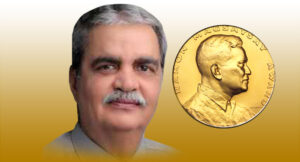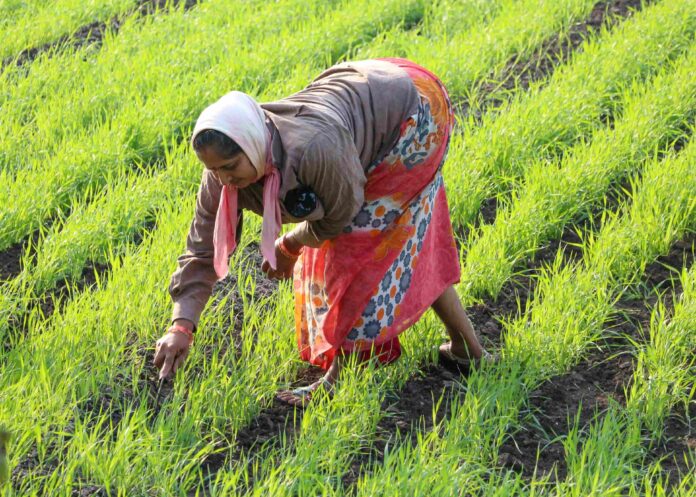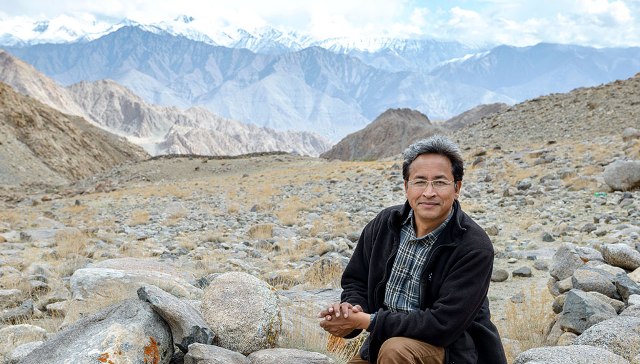आरबीआई जल्द ही 100 रुपये का नया नोट जारी करेगा
नोट का है गुजरात कनेक्शन, नोट के पीछे ‘रानी की वाव’ की तस्वीर है
CSR: Harvesting Water For Saving Farmers’ Livelihoods
Climate change has caused a lot of draughts and unseasonal rainfalls in several parts of the country. Especially in the western state of Gujarat in India, after the earthquake in 2001, the unseasonal rains caused floods in several places, and then droughts hit the state in summer with no water available. This situation caused major impact to farmers.
The soil in the arid regions of Gujarat has high salinity. This creates an impermeable layer on the top during the rainfalls causes water logging in the fields. Standing water on top of soil further increases the salinity of soil, making it unsuitable for farming. Every year, 29 million acres of land is lost to dessert. In this land about 20 million tons of grain could have been grown. People whose livelihood depend on the land, often feel helpless and migrate to cities to look for work. In fact, according to the United Nations Convention to Combat Desertification (UNCCD), 135 million people could lose their homes and livelihoods to desertification by 2030.
In order to help these farmers in crisis and keep them from losing their livelihoods, Biplab Ketan Paul, the director of Naireeta Services, innovated a water harvesting technique called Bhungroo. Bhungroo is a Gujarati word which means straw. In this technique, a pipe with 4-6 inch diameter is inserted into the soil at places where the water is logged. This injects all the excess rainwater underground and stores it there for later use in dry months. This water can be pulled out using pump when needed. The underground reservoir can hold up to 40 million litres of water.
After their success in Gujarat, Naireeta Services joined hands with several entities to replicate the technology in different parts of the country. The organisation has transformed 40,000 acres of barren or disaster affected farms and installed the technology in farms across Gujarat, Jharkhand, Bundelkhand, UP, Karnataka, Andra Pradesh and Bihar.
The price of Bhungroo has been subsidised under Nation Rural Livelihoods Mission. Thus, for a person under poverty line, the Bhungroo is installed free of cost, where as for others, the price is a subsidised rate of 5000 rupees.
Thank you for reading the story until the very end. We appreciate the time you have given us. In addition, your thoughts and inputs will genuinely make a difference to us. Please do drop in a line and help us do better.
Regards,
The CSR Journal Team
सीएसआर फंड पर सख्त हुई सरकार
कॉरपोरेट सोशल रेस्पॉन्सिबिलिटी को लेकर नरेंद्र मोदी की सरकार अब सख्त रवैया अपना रही है। समाज में नीतिगत बदलाव लाने के लिए जो कंपनियां और कॉर्पोरेट हाउसेस अपनी जिम्मेदारी को नहीं समझ रहे है और खुद के मुनाफे के लिए सीएसआर फंड के करोड़ों रुपये की हेराफेरी कर रहे है, उन कंपनियों पर सरकार ने नकेल कसना शुरू कर दिया है। सरकार ने कॉरपोरेट सोशल रेस्पॉन्सिबिलिटी यानि सीएसआर पूरी नहीं करने पर 272 कंपनियों को नोटिस दिया है। गौरतलब है कि ये वो कंपनियां है जिन्होंने अपने सीएसआर फंड का या तो इस्तेमाल ही नहीं किया या इन कंपनियों ने सीएसआर फंड में कुछ गड़बड़ियां की है। कॉरपोरेट अफेयर्स मिनिस्ट्री ने 1,000 कंपनियों के रिकॉर्ड की पड़ताल की शुरुआती जांच के आधार पर 272 कंपनियों को नोटिस भेजा गया है।
सीएसआर के महत्व को समझते हुए हाल ही में सेंट्रल स्क्रूटिन एंड प्रॉसिक्यूसन मेकेनिज्म यानि सीएसपीएम का कॉरपोरेट अफेयर्स मिनिस्ट्री द्वारा गठन किया गया था, सीएसपीएम इन कंपनियों के सीएसआर खर्च पर नज़र रखने का काम करती है। कॉरपोरेट अफेयर्स मिनिस्टर पीयूष गोयल ने राज्य सभा में बताया कि लगभग 1,000 कंपनियों के रिकॉर्ड को खंगाला गया है और शुरुआती जांच के आधार पर 272 कंपनियों को नोटिस भी भेजा गया है। सीएसआर को लेकिन सरकार ने कानून बना तो दिया था लेकिन इसके इंप्लीमेंटेशन पर हमेशा से ही सवाल उठते रहे है, बड़ी कंपनियां और कॉर्पोरेट्स इस कानून को हलके में लेती थी, नियमों की अनदेखी और उलंघन भी बड़ी कंपनियां और कॉर्पोरेट्स करते रहे है, लेकिन सरकार के इस सख्त रवैये से सीएसआर फंड का बेजा इस्तेमाल में जरूर कुछ बदलाव आएगा।
हम आपको बता दें कि साल 2014-15 में 254 कंपनियों पर एक्शन लिया गया। 6,286 कंपनियों में से 2,203 ने अप्रैल-नवंबर 2016 में निर्धारित से ज्यादा राशि सीएसआर पर खर्च की। 3,718 फर्मों ने तय रकम से कम खर्च किया। 346 कंपनियों ने सीएसआर के तहत कोई राशि खर्च नहीं की। कंपनी लॉ के मुताबिक मुनाफे वाली कंपनियों को तीन साल के नेट प्रॉफिट का 2% सामाजिक कार्यों पर खर्च करना पड़ता है। ऐसा नहीं करने पर वजह बतानी पड़ती है। सीएसआर पूरा नहीं करने वाली कंपनियों के खिलाफ रजिस्ट्रार ऑफ कंपनीज कार्रवाई करता है।
बहरहाल ये कोई पहला मामला नही है जब कॉरपोरेट अफेयर्स मिनिस्ट्री ने इन कंपनियों को सीएसआर फंड को लेकर नोटिस भेजा हो, इसके पहले भी बड़े कॉर्पोरेट कंपनियां जांच के घेरे में आई है लेकिन कार्यवाई के नाम पर ढाक के तीन पात ही साबित हुए है। सरकार का ये कदम काबिले तारीफ़ तो है लेकिन नोटिस भेजने में जितनी तत्परता सरकार दिखा रही है, वैसे ही इन बेपरवाह और सामाजिक गैरजिम्मेदार कंपनियों पर नकेल भी कसी जानी चाहिए।
Migsun to Provide 15,000 Affordable Houses in NCR by 2020
Migsun, with approx 640692.85 sq.m. of delivered space in both real estate and construction contracting, has come up with their vision plan for 2020: the group will be providing 15,000 affordable houses in NCR out of which 3000 units will be delivered by the end of 2018.
The group will be using 1 crore sq ft of area in total for the construction of nine projects and expects total investment of INR 3,000 crores approximately included under their plan. Each unit will be spread over a land of 660 sq ft for 2BHK & 1,000 sq ft for 3BHK and will offer a new living experience in the Greater Noida and Ghaziabad at a very attractive ticket size & price window starting from 15.99 lacs for 2 BHK and 25.99 lacs for 3 BHK in the NCR area.
Legalising Sports Betting And Gambling, The Perspectives
As shocking as it sounds, gambling could soon become legit. The Law Commission, in a report to the government, has recommended legalising sports betting and gambling. With the greater acceptance of liberal values in India, it’s harder to support a moralistic ban.
The role of gambling in revenue generation is not new, even during Kautilya’s era gambling was a state-regulated industry with a 5% tax on winnings. Once upon a time gambling with dice games was very common in India. The origin of gambling in India can be traced back to ancient texts. In the Mahabharata, Yudhisthira lost his whole fortune during a dice game– a defeat which forced the five Pandava brothers and their wife to go into exile.
The stakes aren’t usually that high, but dice was used to determine fortunes centuries ago. Less palatable gambling in India is betting on bull fighting, cockfights, goat fights, a tradition which unashamedly still lives on in many parts of the world.
Bets on rainfall are taken during set periods in the day and in the monsoon season, people used to gamble on when and how much it would rain. Rain gambling was very common in Calcutta. It was actually outlawed, but apparently still takes place. Other unusual types of gambling included figuring out the price of opium, and even betting on the cost of food, jute and cotton. The people of India really did bet on anything and everything.
For a nation where cricket is the first love, cricket bets (illegal ones) are big business. Cricket gambling is a sports-oriented activity in itself. Betting in hockey, basket ball, football, badminton matches is very common in India. There is one simple reason for choosing sports gambling over other forms. Setting aside the entertainment factor, people have a better chance of winning consistently.
Sports gambling offers a unique skill-based opportunity for winning. Sports betting essentially involves two opposing bets by individuals with the sports book acting as a sort of broker. The sports book makes its money from the broker fees – the “juice” – and will adjust the odds and betting lines up or down to try and assure a roughly equal number of bettors on both sides of any proposition.
The individual bettor is pitting his judgment on the outcome of an event against the judgment of another bettor. By doing the homework before making a bet, one can directly increase the chances of winning his bets — particularly over the long run.
The first and foremost benefit from legalising gambling will be revenue generation for states. The second is that it provides a set of choices for the consumer. However, these benefits bring with them problems also: increased crime, loan sharking (taking loans at exorbitant rates for gambling), worsening of the living standards of the poor and lower middle class, and changes in behavioural norms and social ethics.
Legalisation gives the government the opportunity to bring gambling out from the dark corners of society, impose some controls and extract some revenue. Once gambling is legal, private information providers would publish data for the expected payoffs associated with alternative gambling providers. A complaint by a citizen about fraud in gambling should be viewed exactly like any other violation of contract, generating investigation and enforcement.
The development of brand names would work as a vehicle for people to identify sound providers of gambling as opposed to scamsters. However, this market deepening would not come about if gambling were simply banned or considered immoral, unethical or peripheral.
CSR: Rating The Political Leaders
Transparency in politics has always been a touchy issue. In India, the availability of structured and organised data about a political leaders is scarce. In order to make a decision to vote, one has to either go through a lot of unorganised and unverified data, or believe the leaders and their promises blindly.
In the corporate world today, the HRs look up at 360 degree feedback before making a decision for any employee. 360 degree feedback includes feedback not only from the supervisor of the employee but also from his peers, subordinates and whoever he has worked with.
In order to make such data available for the citizens, a Delhi based entrepreneur has launched a mobile app called ‘Neta’, inspired by the US’s approval rating system. The app is attempting to get Indian voters to monitor their elected representatives and hold them accountable for their actions.
“We realised from our experience in the US that these polls make a lot of difference both in terms of forming a public opinion and keeping leaders accountable,” said Mittal, whose company, Shanthi Foundation, owns Neta. “In India, there is hardly any (transparent) data around approval ratings or popularity. We saw a clear void in the Indian market and that’s what we want to fulfil,” he told Quartz.
The app was introduced to the public during February by polls in Rajasthan’s Ajmer and Alwar constituencies and was further utilised in Karnataka during the assembly elections in May. Currently, the app has over 2.5 million users from these two states. Hence, it is all set to go national for the 2019 general elections.
The app lists all the candidates in a constituency for the users to rank them. It avoids any duplication of votes by asking for an OTP with each registration of vote. This way, the data available is organised and consists of public opinion about each political leader.
Currently, the app is unavailable for all the states. However, it will soon be made available to the voters as and when the states go for polls. The company expects to have around 100 million users on the app by 2019 general elections.
“I want people to be a little more educated about who they are voting for, and post-2019 elections (ensure) that politicians actually do care about their rating on the app,” Mittal said to Quartz.
Thank you for reading the story until the very end. We appreciate the time you have given us. In addition, your thoughts and inputs will genuinely make a difference to us. Please do drop in a line and help us do better.
Regards,
The CSR Journal Team
CSR Campaigns For International Tiger Day
As the world celebrates International Tiger Day on July 29, let’s work towards protecting these majestic creatures in all their glory.
The tiger isn’t merely a charismatic species or simply another wild animal living in some faraway forest. It is an incomparable animal which plays a critical role in the health and diversity of an ecosystem. Unfortunately, if the tigers go extinct, the entire system would collapse and it will be a catastrophe for mankind.
Fortunately, India is home to more than 70% of the world’s tiger population and Nagpur is unofficially considered as the “Tiger Capital of India.” It is therefore unpardonable that at 23 tiger deaths, Maharashtra stood second only to Madhya Pradesh in tiger deaths nationwide last year. Luckily, its tiger population is steady with 86 in Tadoba National Park, Nagpur.
What is International Tiger Day?
This year marks the eighth Global Tiger Day. Established in 2010 at the Saint Petersburg Tiger Summit, July 29th is dedicated to the worldwide awareness and support for tiger conservation. Less than a century ago, 1,00,000 tigers roamed the forests of Asia, but today less than 3,000 tigers survive in the wild.
Government goals
Union minister Harsh Vardhan on Friday said the government has set a target of doubling the tiger population in the country, reports PTI. Speaking at an event in the run-up to ‘International Tiger Day’ on July 29, Vardhan said that if tigers are conserved, the country will then also be able to protect the environment and deal with environmental threats that exist in the world. Vardhan also said the Rajya Sabha that advanced strategies are being adopted to tackle the human-animal conflict and detailed advisories were being issued to the state governments.
Meanwhile, various corporate entities are focusing their CSR initiatives on saving India’s iconic cat.
Preserve What’s Precious
PWP (short for Preserve What’s Precious) is one such pioneering initiative (towards the long-term conservation of tigers) supported entirely by JetPrivilege and implemented by The Corbett Foundation (TCF) in the Central Indian Landscape – Bandhavgarh Sanjay Dubri Corridor. By going the extra mile, JetPrivilege not only focuses on the tiger species but also its habitat and its affiliation with the man. PWP project addresses the important issue of maintaining the tiger habitat connectivity by undertaking reforestation on over 90-hectares of degraded forest land.
Active Collaborations
Signpost India, a media company in Nagpur city, in active collaboration with the Forest and Revenue Department of Maharashtra, invited all major brands across India to lend support for the “Save the Tiger” initiative by allowing them to put up advertisements across various bus shelter locations in Nagpur. This campaign kick-started on 27th July and was free of cost for the participating brands.
State Bank of India is also a ‘zoo parent’. The bank on Tuesday adopted 15 tigers in the Nehru Zoological Park in Hyderabad as part of the zoo’s Animal Adoption Programme.
‘Save Our Tigers’ is a CSR initiative by Aircel aimed towards environment and tiger conservation. Aircel has been working with several organizations, extending infrastructure and capacity support. The company has associated with tiger conservationists like Mike Pandey, Shekar Dattatri, Valmik Thapar, Bittu Sahgal and others to spread the message of ‘Save our Tigers’. Says Sankara Narayanan K, Head SBU 1 – Chennai and ROTN, Aircel, “We have been working diligently towards tiger conservation since 2008. We will plan more initiatives in the future as part of our campaign.”
Music: A Performance Booster For Athletes
Think of a Premier League game, any premier league game from last season. When the players are walking into the stadium, there’s one accessory ― in the case of many, it will resonate with almost any of us; it’s their headphones. This isn’t isolated to footballers only. Rather, it’s a ritual that is embedded in the sporting ecosystem. Music is a form of self-expression and so often, lost in the vicious cycle of winning and losing and that we tend to forget that these athletes, beyond embodying athletic excellence, are expressing themselves in front of an audience that ranges from a few hundred to many thousands.
This shouldn’t surprise any of us. Before a big game, seasoned professionals are also at the mercy of doubt, nervousness and afflicted by a bout of what ifs, and their response ― like most of us ― is to seek calmness and tranquillity.
Just like us, they also seek refuge in a playlist. In the world of music notes and decibels.
But does music help in enhancing athletic performance? Can we say an athlete did better because he or she heard something from the stands or listened to a favourite groove before going out onto the field?
Earlier this year, research done with over 150 participants stated that listening to motivational music didn’t necessarily improve athletic performance, but it did increase the risk-taking threshold. What would pique the interests of anyone who believes in the power of a playlist?
Researchers found that there was a positive impact of performance when the subjects were allowed to ‘choose’ their motivational music. However, outside of risk-taking, the results were focused on the psychological aspects rather than a reflection of improved self-esteem and how it helped them have a better mind-set.
So, the next time you see the All Blacks perform the Haka, the reason could be less about intimidation ― although rugby players have stated that it is indeed unnerving and more to do with getting into the right mind-set before a game.
On the other side of the aisle, Costas Karageorghis, who for over two decades has worked extensively on the effects of music on the brain, believes that music can have a direct correlation to athletic performance. Karageorghis found that listening to music helped stimulate certain parts of the brain that are responsible for our motor functions and our rhythm and coordination. Moreover, he also stated that music helps in the reducing the levels of cortisol – a hormone related to stress.
Perhaps, the most interesting take from Karageorghis’ research is that synching the tempo of a track to your heart rate can lead to positive outcomes like an increase in stamina but the caveat here is that if the tempo reaches over 140 BPM (beats per minute), the impact wears off.
Sticking to endurance, in another study done by Brunel University, researchers found that listening to music resulted in a 12% reduction of the subjects’ perceived effort whilst at the same time improved endurance by 15%.
For athletes who listen to music pre-event, the consensus didn’t huddle around performance. Instead, they stated that music helped them get pumped up. A classic example of this is Haile Gebrselassie – arguably the greatest long-distance runner of all time. The Ethiopian made it a point to request organizers to play the techno track Scatman ― which has a BPM of 135 ― during his races as he felt it helped him run better. But what if the emotion before an event is that of anxiety and nerves? To keep herself calm and not overly excited before a big race, Kelly Holmes ― a two-time
Olympic Gold- Medallist ― would listen to Alicia Keys’ No One in order to ascend to a state of Zen-like calm and more importantly, not succumb to anxiety.
The impact of music on athletic performance is incredibly varied and you can’t lock down one track of one playlist that will drastically spur an athlete into performing at elevated levels. But researchers across the board have definitely found that while music’s impact on athletic performance is still debatable, there seems to be a correlation between music and the psychological state of an athlete.
 The author, Sanjeev Anand, is Country Head – Commercial Banking and in-charge of Sports Vertical, IndusInd Bank and an avid sports enthusiast.
The author, Sanjeev Anand, is Country Head – Commercial Banking and in-charge of Sports Vertical, IndusInd Bank and an avid sports enthusiast.
Views of the author are personal and do not necessarily represent the website’s views.
Thank you for reading the story until the very end. We appreciate the time you have given us. In addition, your thoughts and inputs will genuinely make a difference to us. Please do drop in a line and help us do better.
Regards,
The CSR Journal Team
CSR: Teachers In India
Dr. A. P. J. Abdul Kalam Azad has said, “If a country is to be corruption free and become a nation of beautiful minds, I strongly feel there are three key societal members who can make a difference. They are the father, the mother and the teacher.”
Teachers have always received a lot of respect in India’s culture. There have always been stories and folktales about the importance of gurus. Be it Dhronacharya, Chanakya, Vishvamitra or Adi Shankracharya, all of them have played a significant role in history and have had very dedicated disciples. In order to honour the teachers, Guru Purnima is celebrated in India and Nepal.
India is going through crisis in terms of number of teachers in the government schools, when 60% of children in India rely on education from these public schools. In fact, there are several schools in rural India that are functioning on just one teacher. According to the data provided by the Union Minister for Human Resource Development to the Lok Sabha in December 2016, 17.51% posts for government teachers at Elementary level was vacant and 14.78% posts for government teachers for Secondary level were vacant in India.
Teaching as a profession is generally considered as the last option for majority of people in India. Hence, most of the teachers in the profession today, are not highly motivated.
Teaching is not a preferred vocation because it lacks a scope of progress, and the pay is not very satisfactory either. Teachers in India do not get pay raises or promotion for years. And their salaries are way below the OECD standard average.
Indian teachers and students have come a long way from the time when a student was willing to cut his own thumb to placate his teacher, and a teacher was willing to give up his life to save his student. In today’s time, the teachers are far from acting as spiritual guides to students. They are more focused on training their students to score more marks in exams so they can get more students again.
However, away from this business of education there are several teachers who are true to their profession and are passionate about it. They are appreciated well by their students too. In order to honour them, let us take a moment today, to remember them, get in touch with them and thank them for the role they played in our lives. It is only when we respect and appreciate those in the profession, monetarily and mentally, will we be able to raise better teachers for the upcoming generation.
Thank you for reading the story until the very end. We appreciate the time you have given us. In addition, your thoughts and inputs will genuinely make a difference to us. Please do drop in a line and help us do better.
Regards,
The CSR Journal Team
CSR: Ladakhi Innovator and Mumbai-based Psychiatrist Win Magsaysay Award 2018
Sonam Wangchuk, who inspired actor Aamir Khan’s character in 3 Idiots, has made India proud. He is one of two Indians to be given the Ramon Magsaysay Award this year, recognised as Asia’s premier prize, “honouring greatness of spirit and transformative leadership.” The prestigious award is given to persons — regardless of race, nationality, creed or gender — who address issues of human development in Asia with courage and creativity, and in doing so have made contributions which have transformed their societies for the better.
Innovator and education reformist, Wangchuk, was felicitated for his uniquely systematic, collaborative and community-driven reform of learning systems in remote northern India, thus improving the life opportunities of Ladakhi youth, and his constructive engagement of all sectors in local society to harness science and culture creatively for economic progress, reported IANS.

Psychiatrist Bharat Vatwani from Mumbai, has been recognised for “his tremendous courage and healing compassion in embracing India’s mentally-afflicted destitute”, started an informal operation of bringing mentally-ill street persons to their private clinic for treatment. Vatwani established Shraddha Rehabilitation Foundation in 1988, aimed at rescuing mentally-ill persons living on the streets; providing free shelter, food, and psychiatric treatment; and reuniting them with their families.
Their rescue work has been aided by the police, social workers, and referrals. Shraddha’s free custodial care and treatment ranges from personal hygiene, medical check-ups, psychiatric treatment, to appropriate medication — all done in the open, healing environment of the Karjat facility, the board of trustees noted in a statement in the Philippines. Since its inception in 1998, the SRF has treated free of cost over 7,000 such wanderers and even helped them to reunite with their families.
Talking to IANS at this Borivali residence, Vatwani said: “I remember, a couple of years ago, the Mother Teresa’s Missionaries of Charity, Mumbai, found a 74-year old man from Punjab, mentally ill and wandering on the streets. We not only completely cured him but reunited him with his family back home 54 years after he went missing.” Vatwani said mental illness affects over 16.50 crore or nearly 14% of all Indians, but 80% of all the districts lack even one psychiatrist in the public health care system. “There are around 3,500 psychiatrists in India or three per million, compared to 100 in Australia or 150 in developed countries, and just one bed for 44,000 patients,” he said.
The other recipients of the annual honour include Cambodia’s Youk Chhang, Maria de Lourdes Martins Cruz from East Timor, Howard Dee of Philippines and Vietnam’s Vo Thi Hoang Yen.
As for Wangchuk, he founded Students’ Education and Cultural Movement of Ladakh (SECMOL) and started coaching Ladakhi students, 95% of whom used to fail the government exams. In 1994, with Wangchuk in the lead, Operation New Hope (ONH) was launched to expand and consolidate the partnership-driven educational reform program. Taking a life of its own, to date ONH has trained 700 teachers, 1,000 VEC leaders, and dramatically increased the success rate of students in matriculation exams from just 5% in 1996 to 75% by 2015.
For a nation as vast as ours with a population of youngsters that exceeds the other age brackets, we don’t have nearly enough role models like Wangchuk and Vatwani. Watch this space for more stories on such real life heroes.
Source: IANS
Thank you for reading the story until the very end. We appreciate the time you have given us. In addition, your thoughts and inputs will genuinely make a difference to us. Please do drop in a line and help us do better.
Regards,
The CSR Journal Team

















